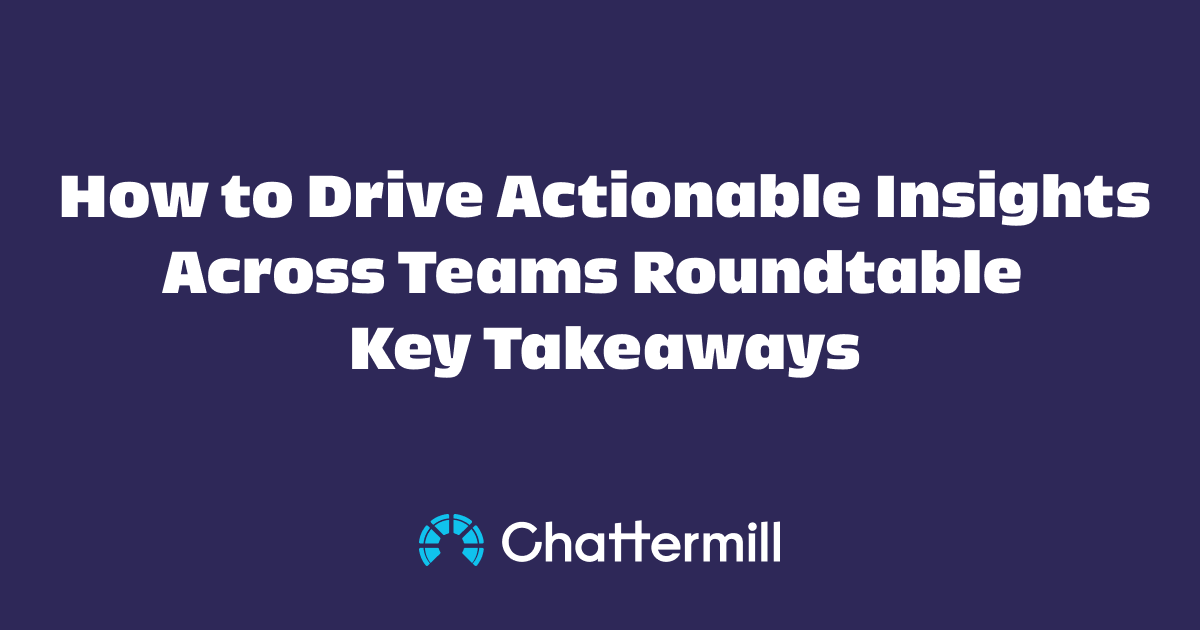What Is A TNPS? (Transactional Net Promoter Score)
Transactional NPS surveys measure customer feedback at a minute level. They should be sent immediately after a customer interacts with a business to better measure how that interaction went and if it affected a customer's satisfaction and the likelihood of promoting the business.
By sending and analyzing tNPS surveys, companies can quickly address pain points that occur along the customer journey. Companies get immediate feedback on whether someone transitions between being a Promoter, Passive, or Detractor. Remember, respondents are sorted into Promoters (respond 9 or 10), Passive (7 or 8), and Detractors (6 or below).
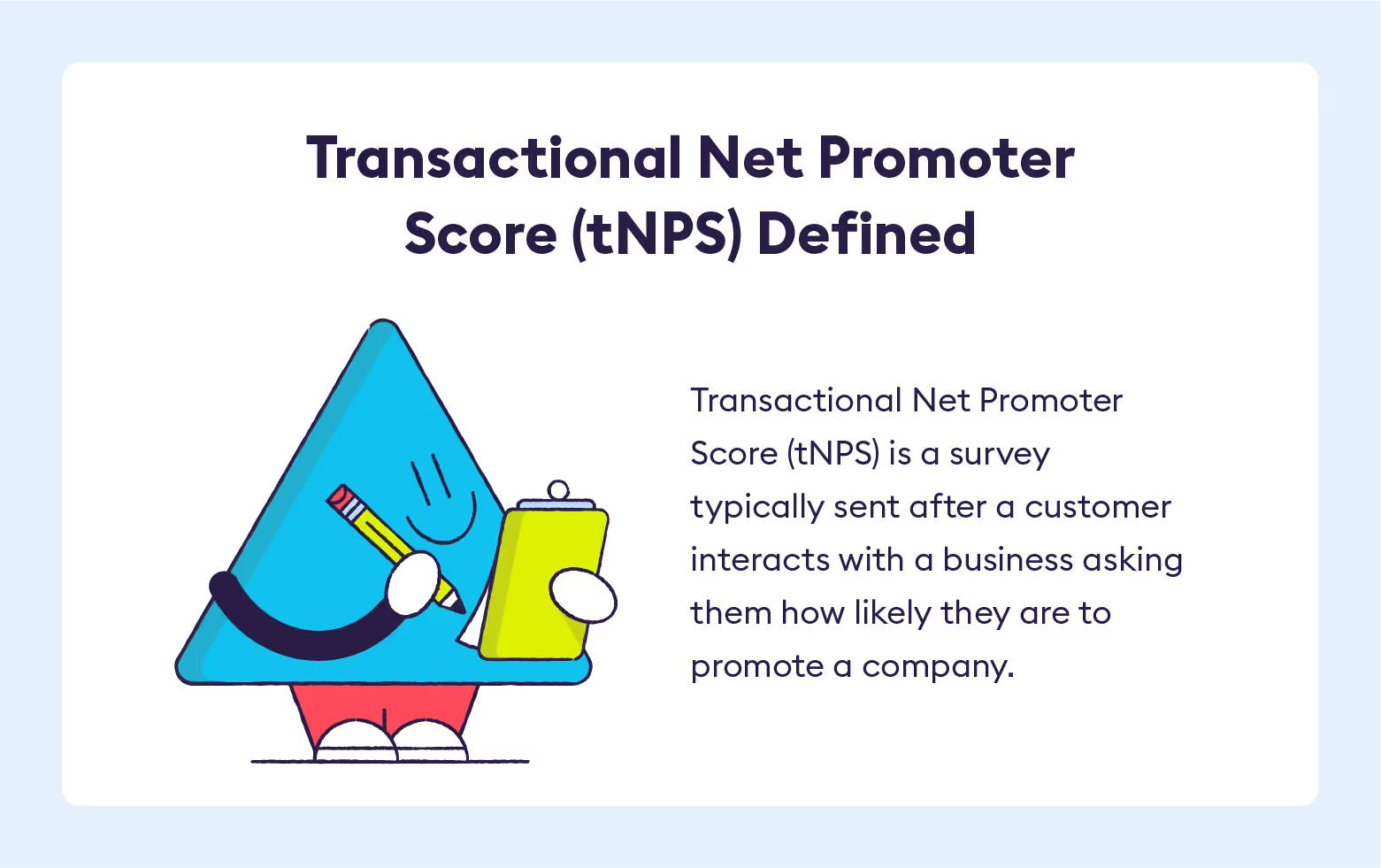
Why Your Business Needs Transactional NPS (tNPS): Exploring Its Benefits
1. Real-Time Insights into Customer Experience
One of the most significant advantages of implementing tNPS is the ability to gather real-time feedback. By surveying customers right after an interaction, businesses can pinpoint what factors contributed to a customer’s level of satisfaction. This immediacy enables companies to respond quickly to both positive and negative feedback, tailoring customer experiences to foster loyalty and encourage repeat business.
2. Identification of Key Pain Points
Understanding the nuances of customer interactions is essential for continuous improvement. tNPS allows organizations to identify specific issues that may not have been apparent in broader customer satisfaction surveys. For instance, a hotel might discover that a particular check-in process is consistently rated poorly. This detailed feedback helps businesses address specific areas for improvement rather than generalizing customer sentiment.
3. Enhanced Customer Loyalty and Retention
By actively seeking customer feedback and showing a willingness to listen and act on it, businesses can build stronger relationships with their clientele. When customers feel heard, they are more likely to become Promoters, advocating for the brand and potentially increasing customer lifetime value. Additionally, promptly addressing concerns can mitigate the risk of customer churn, enhancing overall retention
What is the difference between NPS and tNPS?
Net Promoter Score (NPS) and Transactional Net Promoter Score (tNPS) are both metrics used to gauge customer loyalty and satisfaction, but they serve different purposes and are employed at various points in the customer journey. Understanding the differences between these two methodologies can provide businesses with deeper insights into customer sentiments and improve overall customer experience.
The best way for businesses to measure the likelihood of a client promoting their business is by measuring their Net Promoter Score (NPS). NPS surveys ask customers on a scale of 1–10 how likely they are to recommend your business to someone else. The higher the score, the more satisfied customers are with a product or service, and the more likely they are to recommend a business.
NPS: The Bigger Picture
There are two kinds of NPS surveys: transactional and relational. The guide below will break down exactly what Transactional NPS (tNPS) surveys are and how they differ from Relational NPS (rNPS) surveys. We’ll also outline which scenarios to use tNPS in and how this survey type is vital for getting key information on customer experience (CX) and customer trust and loyalty.
NPS is a broader metric that assesses customer loyalty by asking respondents a simple question: “On a scale from 0 to 10, how likely are you to recommend our product/service to a friend or colleague?” It is typically measured at a strategic level, assessing overall customer satisfaction over time. This metric provides businesses with a general sense of their customer base's loyalty and is often used in quarterly or annual surveys.
How do you calculate transactional NPS?
To calculate transactional NPS, follow these straightforward steps:
Step 1: Survey Distribution
Begin by distributing the tNPS survey immediately after a customer interaction. This could be after a purchase, a customer service call, or any significant interaction with your product or service. The timing is crucial, as it helps capture the customer's sentiments while their experience is still fresh.
Step 2: Collect Responses
Once the survey is distributed, collect the responses without delay. Typically, the survey should consist of the key question: “On a scale from 0 to 10, how likely are you to recommend our product/service based on your recent interaction?” You may consider supplementing this question with an open-ended follow-up to gather qualitative insights.
Step 3: Categorize Respondents
After collecting the responses, categorize the customers into three distinct groups:
1. Promoters (Score 9-10)
Promoters are your most enthusiastic and loyal customers who are likely to recommend your product or service to others. This group believes in your brand and contributes to positive word-of-mouth marketing. It’s crucial to engage with Promoters actively, as they may provide valuable testimonials and advocacy for your business.
2. Passives (Score 7-8)
Passives are satisfied customers, but they are not as emotionally invested as Promoters. While they might be content with your service, they are also susceptible to switching to competitors if they find a better offer or experience. It’s essential to keep Passives engaged and address any areas of concern that might push them into the Promoter category.
3. Detractors (Score 0-6)
Detractors are dissatisfied customers who may share negative experiences and discourage others from using your service. They represent potential threats to your brand's reputation. Addressing their concerns promptly and effectively is vital in mitigating damage and transforming their views. Engaging with Detractors also offers an opportunity for improvement based
Step 4: Calculate Score
Calculating your tNPS (Transactional Net Promoter Score) involves a straightforward formula. Here’s how you can do it.
1. Count Your Responses
First, tally the total number of respondents across all categories: Promoters, Passives, and Detractors.
2. Determine the Totals
For the calculation, you will need the number of Promoters and Detractors. It's important to exclude Passives from this specific calculation, as their opinions do not impact the tNPS score directly.
3. Use the tNPS Formula
The tNPS score is calculated as follows:
tNPS = (% of Promoters) - (% of Detractors)
Convert the number of Promoters and Detractors into percentages based on your total number of respondents. For example, if you have 80 Promoters out of 200 total responses, that represents 40%. If you have 20 Detractors, that accounts for 10%. Plugging these values into the formula:
tNPS = (% of Promoters) - (% of Detractors)
tNPS = 40% - 10%
tNPS = 30
Your resulting tNPS score of 30 suggests a generally positive customer experience, as there are significantly more Promoters than Detractors. In most contexts, a score above zero indicates a favorable perception among your customers, but it's critical to delve deeper into the underlying reasons behind these scores.
Click here to learn what a good net promoter score is and how to improve it.
Step 5: Analyze Results
Once you have your tNPS score, it’s time to analyze the results thoroughly. Examine the comments and feedback provided by respondents to understand their quantitative scoring.
- Identify Key Trends - Look for patterns in the feedback from Promoters and Detractors. What do Promoters love about your service? What specific pain points do Detractors mention? Uncovering these insights will inform your business strategies moving forward.
- Segment Your Audience - Consider segmenting your results based on various demographics or customer profiles. This may include age, location, purchasing habits, or customer touchpoints. By segmenting, you can discern whether specific groups of customers are more likely to endorse your product or service—or display dissatisfaction. This targeted approach can inform personalized strategies that enhance the customer experience for varying audience segments.
- Optimize Touchpoints - Analyze the touchpoints highlighted in customer feedback. Were there particular interactions, such as customer service engagements or checkout experiences, that received more negative comments? Understanding where these critical touchpoints lie allows you to make targeted improvements, ensuring a smoother and more satisfying experience for your customers.
- Track Improvements Over Time - Regularly check your tNPS scores and analyze feedback to see if improvements
Types Of TNPS Surveys To Send
Businesses should be strategic about when they send tNPS surveys. They should be sent after important transactions or exchanges such as a customer service call, a purchase, or after a demo trial. We'll go into more detail for these different scenarios below.
1. Post Purchase
A tNPS survey can be sent either directly after a customer completes a purchase or once a shipment is confirmed. If any issues occurred with either the transaction or the product delivery it's best to automate a tNPS survey sooner rather than later so a business can measure the impact this issue had on its customer loyalty. Using this captured data, businesses can be proactive and better prepared for future orders.
2. Customer Call Or Interaction
Anytime a customer interacts with a customer sales or support representative via telephone, email, or chatbot a transactional survey should be conducted. Sending a tNPS survey will reveal several data points:
- Which service channels do customers enjoy interacting with most
- Issues with customer service channels such as neglection, timeliness, or unresolved problems
- Overall customer satisfaction (CSAT) with a product and pitfalls that need addressing
For instance, if several customers move from promoters to passives or detractors after interacting with a company's customer service department, then that department likely needs examining.
Vice versa, if clients are moving from passives or detractors to promoters after communicating with a customer service team, that unit should be rewarded and their communication strategies shared across other departments.
3. Onboarding A New Customer
- The onboarding process and experience is an essential part of the retention stage in the customer journey.
- Companies must constantly assess their onboarding process. tNPS surveys can help do this by fixing recurring issues or complaints, which also helps with customer retention.
The onboarding experience is an essential part of the retention stage in the customer journey map. tNPS surveys will give insight into how new clients perceive the onboarding experience — which heavily influences if a customer will churn or not.
For onboarding tNPS surveys, it can be beneficial to send two-question surveys. One of the questions should be open-ended, to get more in-depth feedback. Businesses can use the qualitative data collected from the tNPS surveys, to understand repeat complaints or flaws in the implementation process. They can then address these issues by reevaluating the product itself, adding more self-help resources, or simplifying specific steps.
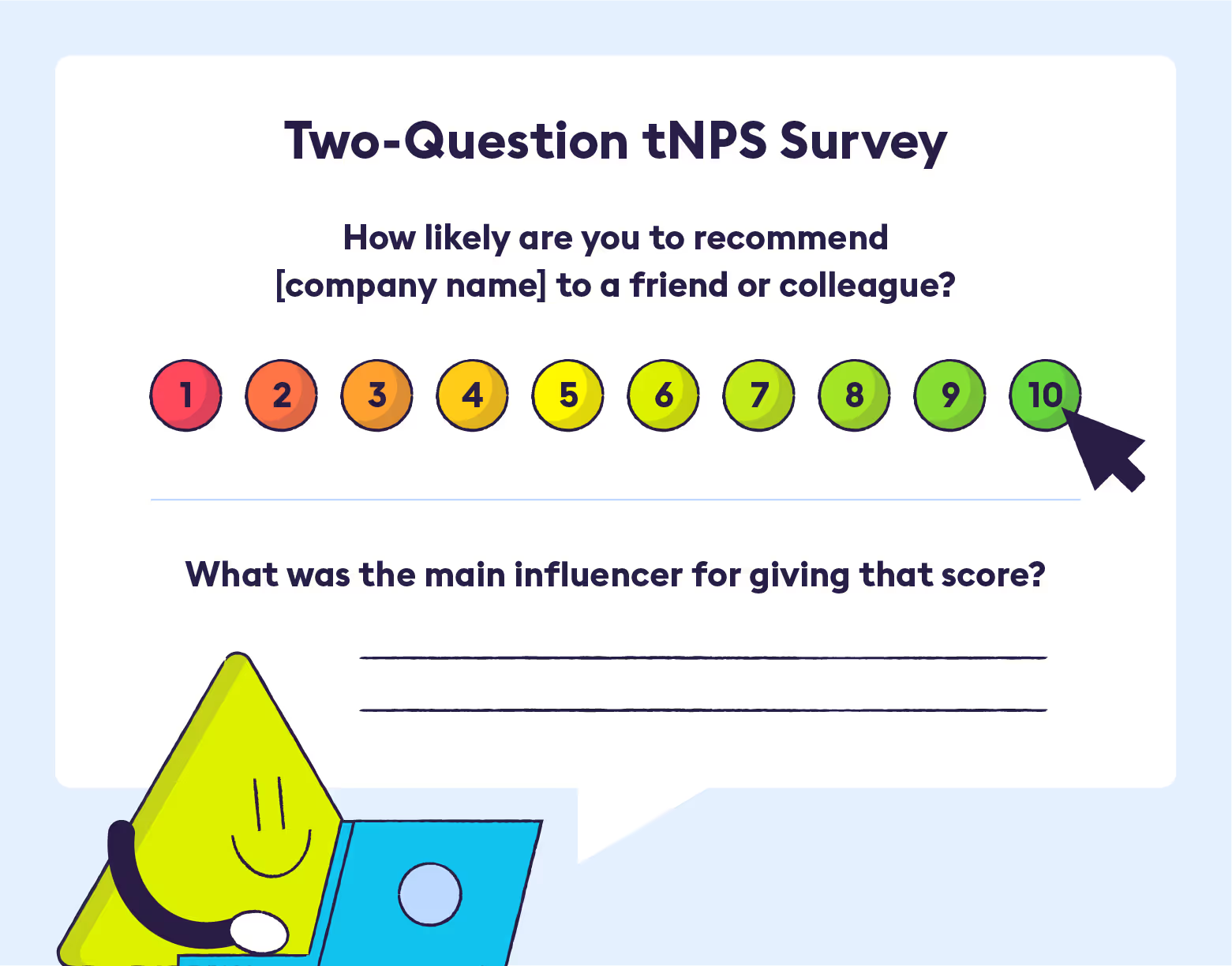
4. Product Update
Whenever a product update occurs, issues often occur. Companies should send tNPS surveys one to two days after product updates or release so they can quickly address and resolve any overlooked issues.
It's also important to send follow-up transactional surveys after the majority of product-related issues are fixed. That way, you can see if your NPS score increases or if customer sentiment is already low and other tactics need to be implemented to regain customer loyalty.
What Is RNPS? (Relational Net Promoter Score)
Now that we've discussed transactional NPS surveys, let's also discuss the other type of NPS surveys, relational net promoter score (rNPS) surveys.
TNPS Vs RNPS
Relational NPS, sometimes referred to as regular or on-demand NPS, gives a bird's eye view of a business' relationship with its clients. rNPS surveys help B2B businesses affirm that their clients are happy with their overall services and product. Consider rNPS surveys as customer satisfaction check-ins with customers.
While tNPS surveys typically get sent after transactions and interactions with customers, rNPS surveys should be segmented and scheduled either quarterly, every six months, or annually.
The Pros And Cons Of TNPS And RNPS
Both tNPS and rNPS have pros and cons. Used together though, they balance each other out. Again, tNPS surveys review singular incidents while rNPS surveys serve as broad-stroke customer check-ins. For companies to get both granular and overarching insight into their CX, they should implement both tNPS and rNPS surveys.
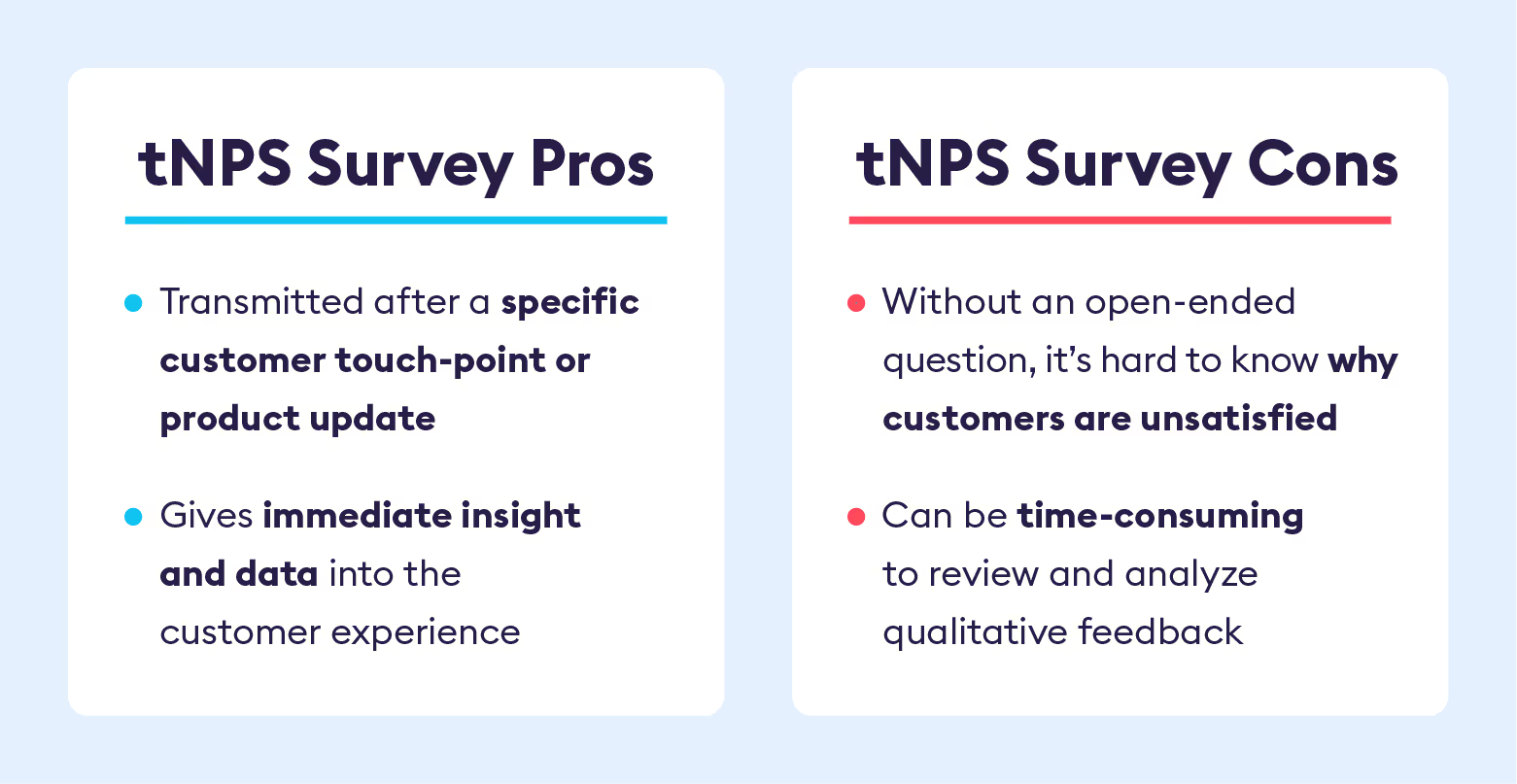
The Pros of tNPS Surveys
- Receive immediate feedback from a customer after an interaction.
- Pinpoint bottlenecks or touchpoints that cause customers to switch between Promoters, Passives, and Detractors.
- Allows businesses to quickly modify a CX pain point to meet customers' needs and desires.
The Cons of tNPS Surveys
- Without a second open-ended question, tNPS surveys don't answer why a customer is or is not satisfied with an interaction.
- Time-consuming to comb through qualitative data and find patterns from open-ended questions.
- Hard to decipher if competitors' tactics and strategies are influencing tNPS survey results.
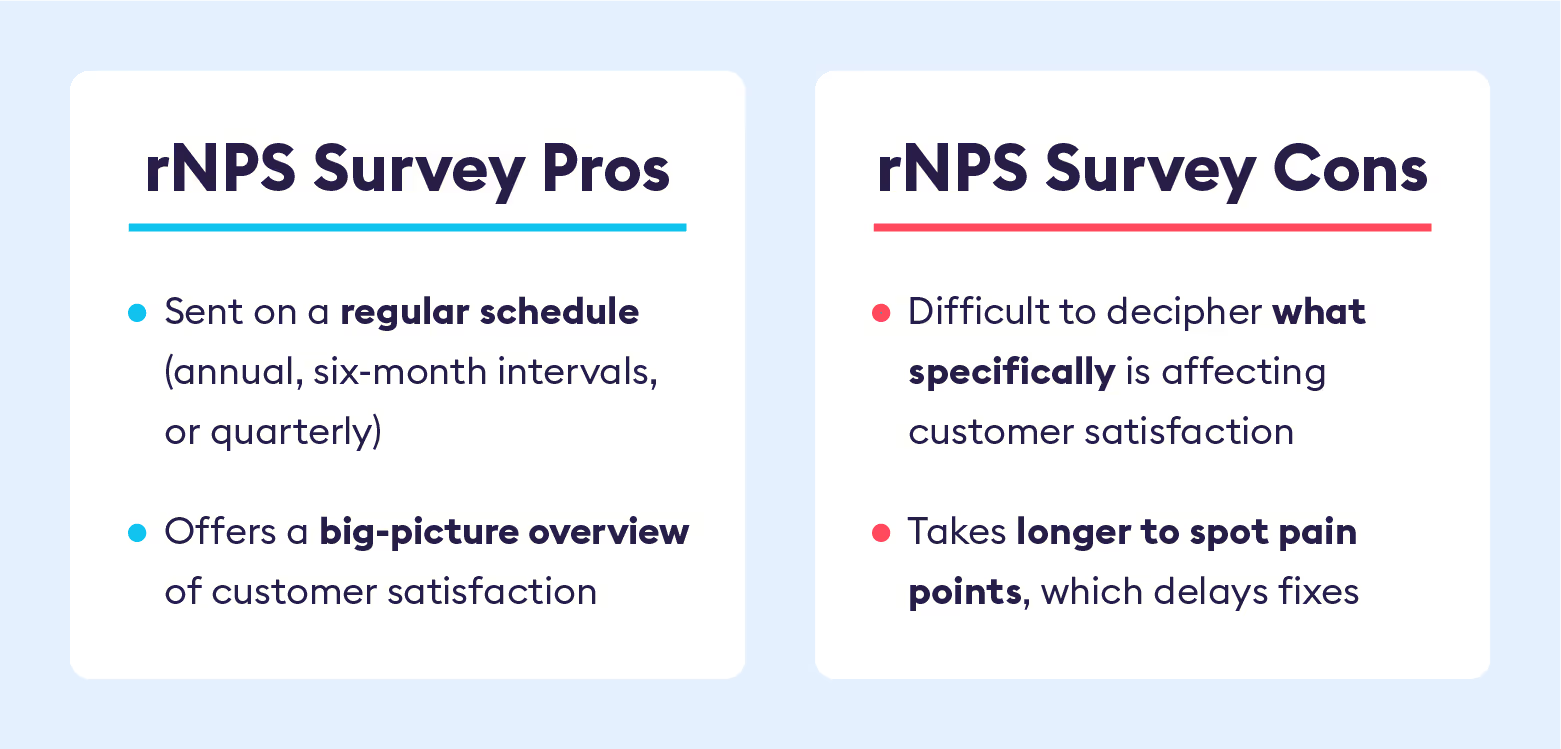
The Pros of rNPS Surveys
- Provides a broad overview of a customer's relationship with a business.
- Helps give timely feedback to make sure both new and long-term customers are satisfied.
- Allows Passive scorers the opportunity to give feedback they wouldn't normally do.
The Cons of rNPS Surveys
- Difficult to decipher if a single incident, such as a poor interaction with a customer service rep, or multiple compound issues (payment, order, and customer service) is affecting the rNPS score such as a single incident or multiple issues.
- Product and software updates or crashes can affect rNPS surveys' schedules.
- Takes longer to pinpoint issues, which prolongs implementing changes from feedback.
Is A TNPS Or RNPS Survey Better?
Neither tNPS nor rNPS is better. What's best for companies is to use both tNPS and rNPS surveys to better analyze the customer experience and properly measure customer effort and satisfaction.
Remember, tNPS surveys are done after singular incidents or transactions. That way, a company is immediately notified of a customer complaint. While rNPS surveys serve as quarterly, bi-annual, or yearly encounters to make customers feel happy and satisfied. Both surveys should be added to your Voice of the Customer toolkit to get minute and widespread feedback.
What matters most is that companies act on their NPS survey data and make the necessary changes to increase customer satisfaction.
How to Implement tNPS Surveys Effectively: A Step-by-Step Approach
Implementing transactional Net Promoter Score (tNPS) surveys can be a game-changer for understanding customer satisfaction at critical touchpoints in their journey. To ensure that your tNPS surveys deliver actionable insights, follow this step-by-step approach:
Step 1: Define Your Objectives
Before launching your tNPS surveys, clarify what you aim to achieve. Are you looking to enhance customer support interactions, improve the online purchasing experience, or measure satisfaction after product delivery? Defining your objectives will help tailor your surveys to focus on specific interactions that matter most to your customers and your business.
Step 2: Design Your Survey
Craft a concise and relevant survey that includes the core tNPS question: “On a scale of 0-10, how likely are you to recommend our company/product/service to a friend or colleague?” Follow this with key driver questions that dig deeper into the customer’s experience. These questions should assess attributes such as ease of use, pricing, product features, and customer service. Ensure that the survey is brief enough to encourage responses while comprehensive enough to gather meaningful data.
Step 3: Timing is Key
The timing of your tNPS surveys is critical for capturing immediate feedback. Send the survey right after a customer interaction, whether it’s after a purchase, a support ticket resolution, or any other significant touchpoint. This approach ensures that customers' impressions are still fresh, leading to more accurate and actionable responses.
Step 4: Automate and Integrate
To streamline the process, integrate your tNPS surveys into existing customer relationship management (CRM) systems or feedback platforms. Automation tools can help send surveys promptly and efficiently, ensuring that you do not miss the opportunity to gather feedback immediately following an interaction. Integration with other feedback systems can also provide a more comprehensive view of customer sentiment.
Step 5: Monitor and Analyze Responses
Once your tNPS surveys are live, closely monitor the responses. Look for trends and patterns in the feedback to identify areas of strength and opportunities for improvement. Segment the data by touchpoint, customer demographics, and other relevant factors to gain deeper insights. Utilize analytics tools to visualize data and facilitate a thorough analysis.
Step 6: Act on Insights
The ultimate goal of tNPS is to drive improvement in customer experience. Use the insights gathered from the surveys to inform your business strategies. If customers highlight specific pain points, prioritize initiatives to address them. Conversely, if certain aspects receive high praise, consider amplifying these strengths through marketing campaigns or customer testimonials.
Step 7: Follow Up with Customers
Timely follow-up with respondents is crucial, especially for detractors (those who score you low). Reach out to understand their concerns better, provide solutions, or apologize for any inconveniences. This proactive approach not only helps regain their trust but also demonstrates that you value their feedback.
Step 8: Continuously Improve
Implementing tNPS surveys isn’t a one-time task; it's an ongoing process. Regularly update your survey questions and follow-up mechanisms to keep them relevant and engaging. Analyze data trends over time to measure the effectiveness of improvements made based on customer feedback, and be prepared to adjust your strategies as needed.
By following these steps, businesses can effectively implement tNPS surveys, transform customer feedback into actionable insights, and ultimately enhance customer satisfaction and loyalty across all touchpoints.
In Summary
Transactional Net Promoter Score (tNPS) is not just another metric; it is a powerful tool for businesses seeking to enhance their customer experience and foster loyalty. By collecting real-time feedback immediately after customer interactions, companies can gain valuable insights into specific touchpoints and identify areas for improvement.
The ability to act promptly on this feedback allows organizations to address customer pain points swiftly and optimize their service delivery. However, the full benefits of tNPS can only be realized when businesses embrace it as a part of a continuous improvement strategy. Regularly refining survey questions, monitoring trends, and actively engaging with customers post-survey are essential steps in this journey.
If you're ready to consolidate customer feedback from various sources and take action on insights, Chattermill's feedback analytics platform can help. Reach out today to see how we can support your business in achieving customer-centric growth through advanced tNPS analytics.
Book a Demo to learn about how Chattermill can help you understand what's driving your tNPS.
Transactional Net Promoter Score (tNPS): FAQs
What is transactional Net Promoter Score and why does it matter?
Transactional Net Promoter Score, known as tNPS, measures customer sentiment right after a specific interaction such as a purchase or support call. It provides immediate feedback that helps businesses quickly address pain points and enhance loyalty.
How is tNPS calculated?
Customers rate their likelihood to recommend on a scale from 0 to 10. Responses are grouped into Promoters (9 or 10), Passives (7 or 8), and Detractors (6 or below). You calculate tNPS by subtracting the percentage of detractors from the percentage of promoters, which results in a score between -100 and +100.
What are the main benefits of using tNPS?
tNPS offers real time insights into customer experience, pinpoints friction points after each interaction, and enables fast, targeted actions to improve loyalty and retention.
How does tNPS differ from relational NPS?
Relational NPS measures overall brand loyalty over time, usually through periodic surveys. In contrast, tNPS focuses on specific touchpoints, giving more actionable insights immediately after each interaction.
When should businesses use tNPS surveys?
Best moments to send tNPS surveys include just after a purchase, a customer service interaction, onboarding, trial periods, or product delivery. This timing captures fresh feedback while the experience is still top of mind.
What types of transactions are ideal for tNPS?
Transactional NPS surveys work well after events such as post purchase, support interactions, trial onboarding, checkout or delivery experiences, refunds or returns, and product demos.
Why is timing so important for tNPS?
Immediate follow up ensures that feedback reflects the actual experience rather than memory or summary impressions. Acting on this feedback quickly helps build stronger customer trust and faster improvements.




